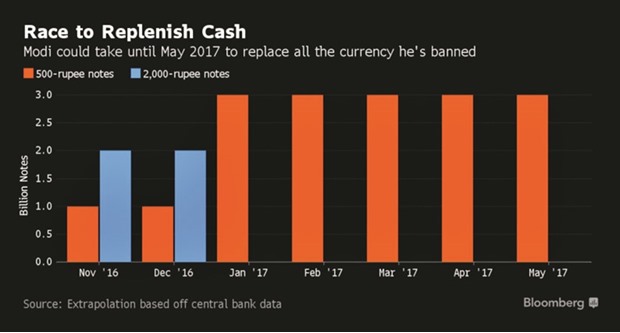For Indians expecting respite from the government’s clampdown on cash, here’s a reality check: It probably won’t come soon.
Prime Minister Narendra Modi’s administration may need until May 2017 to replenish the stock of now worthless bills, according to Saumitra Chaudhuri, an economist who advised Modi’s predecessor. The government on November 8 banned 500 ($7.5) and 1,000 rupee notes in a surprise move against graft and tax evasion.
Delays in replacing the currency risk prolonging the pain in the $2tn economy, where about 98% of consumer payments are made in cash. Deutsche Bank predicts the crunch could easily shave off a half-point from India’s growth in October-December, which could imperil its position as the world’s fastest-growing major market.
This is how Chaudhuri reached his conclusion, which he published in a blog post on the Economic Times’ website: Extrapolating from central bank data, he estimates that Modi’s move sucked out about 16.6bn notes of the 500-denomination, and 6.7bn 1,000-rupee bills. That means more than 23bn notes totalling 15tn rupees.
Modi intends to replace these with new 2,000-rupee and 500-rupee bills. However, Bharatiya Reserve Bank Note Mudran Pvt, which prints the higher denomination currency, has a stated capacity of just 1.3bn notes a month. That’s with working double shifts. Raise this to triple shifts and it becomes 2bn bills, which means it will need until the end of 2016 to replenish in value the 1,000-rupee notes.
Security Printing & Minting Corp of India Ltd, whose capacity Chaudhuri estimates at 1bn pieces a month, will need several more months to meet the 500-rupee target, even if it joins forces with BRBNM, he said.
“Ergo, currency shortages will remain with us for many months and economic contraction will rule this period,” he wrote. “At the end of the period, confidence will be at new lows and recovery will take time.”
In what could make matters worse, the presses – busy with the new bills – have almost completely stopped printing 100-rupee notes, Bloomberg Quint reported on Wednesday citing central bank sources it didn’t name. These bills are the bread-and-butter of India’s $780bn informal economy, which employs more than 90% of the workforce.
Finance Ministry spokesman DS Malik rejected the assessment. “This is not correct, things will improve shortly,” he said. “Once supply of Rs500 and Rs100 notes increases and re-calibration of ATMs is over, which is underway on a fast pace, the situation will improve to a huge extent.”
There is a “sufficient” supply of bank notes as production started nearly two months ago, the central bank said in a statement yesterday.
The ministry’s officials, however, admitted the government is falling far short of meeting requirements for 100-rupee notes. They declined to be identified, citing rules on speaking with the media.
In a teary-eyed appeal, Modi on Sunday requested Indians to bear the pain for 50 days. “After that, if any fault is found in my intentions or my actions, I am willing to suffer any punishment given by the country,” he said.

People in News


